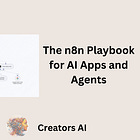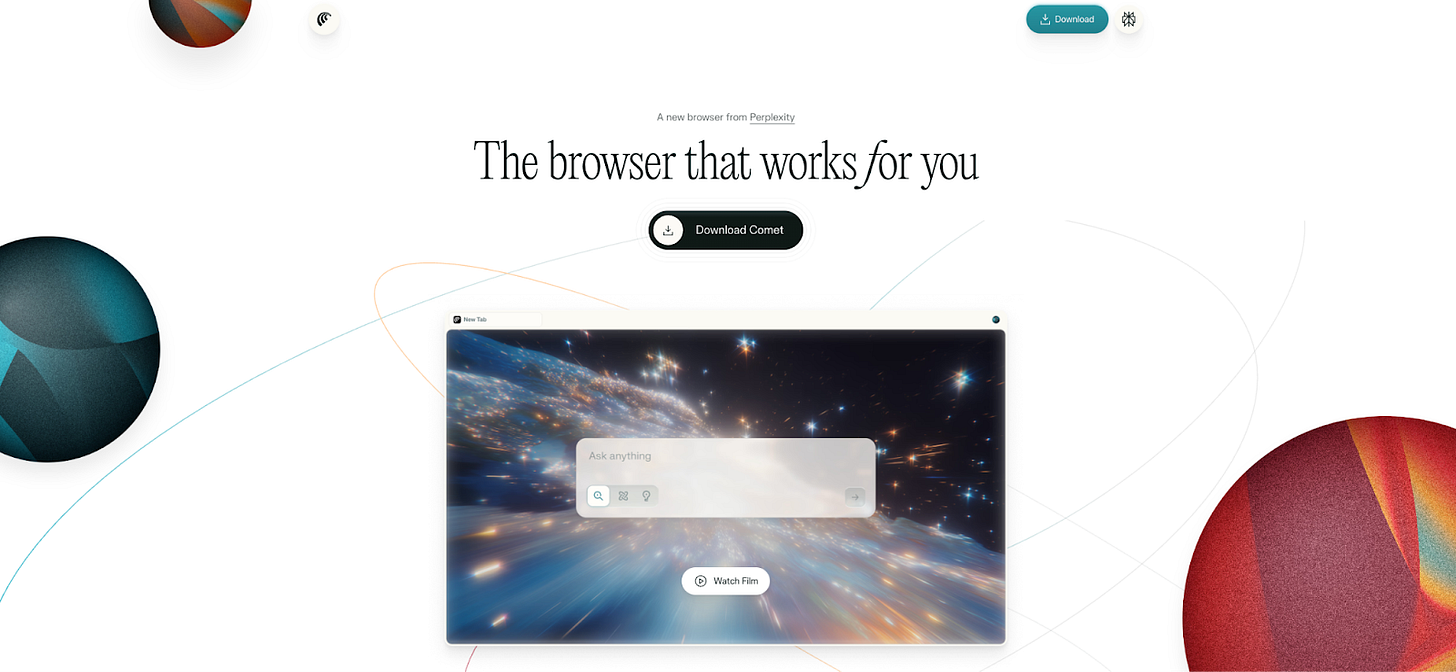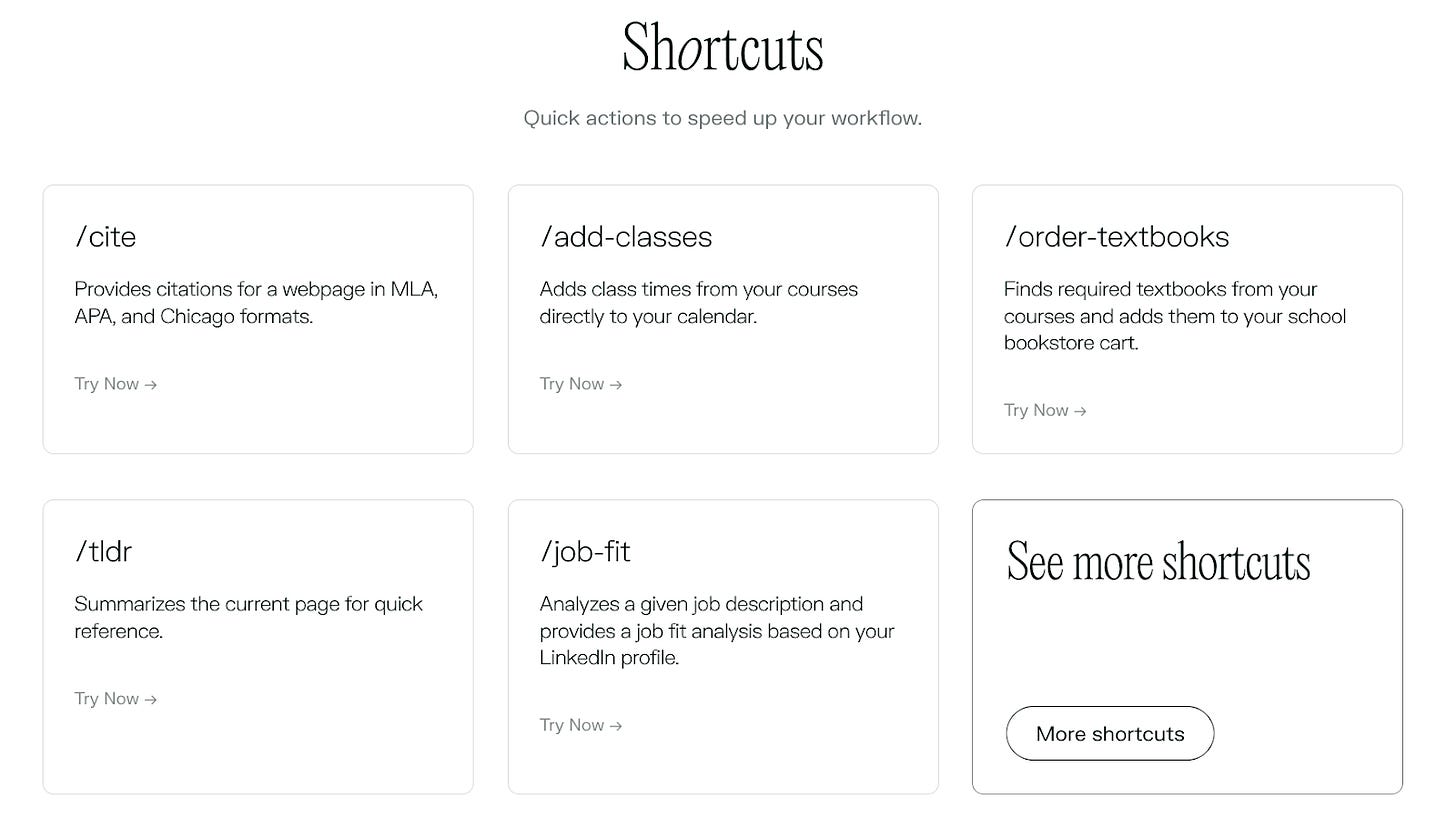Comet Browser by Perplexity: 40+ Use Cases
Learn How To Use Native AI Browser
Hey!
Perplexity recently showcased some interesting updates with Email Assistant, Notion & GitHub integration, but we want to pause and dive deeper into their browser, which has recently become public. By the way, the post is not sponsored, and it’s our personal review & opinions about Comet.
This post is prepared with Guest Author - Daria Cupareanu. Creator of AI Blew My Mind
If you also want to be featured at Creators AI - send us email here.
For the past years, I’ve been exploring how far AI can actually go in practice. I push tools until they break, prototype quick builds, and stress-test ideas until I can share what actually works, saving others the dead ends I ran into.
Along the way, I’ve vibe-coded products in a weekend, worked with agentic tools like ChatGPT’s agent and Manus, explored how to work smarter with LLMs, and even built AI agents in n8n that now handle real tasks for me.
Check our last post with tutorials about n8n:
AI has given me leverage I never had as a non-technical person, and now I share what I learn so others can use it to advance in their work, career, and business.
Through all this experimenting, I’ve noticed a pattern. A lot of the tools I try don’t live up to the hype. They’re fun to test, but they don’t stick in my workflow.
Every once in a while though, one actually changes how I work day to day.
Perplexity Comet is one of those tools.
Before Comet, I spent two weeks trying Dia as my AI-assisted browser. It was way better than Chrome for research and writing, but when I got access to Comet, I had to test it. And I haven’t looked back since.
Comet didn’t just replace Dia. It replaced my entire browsing workflow. It’s stronger, more responsive, and far more reliable. Where Dia would stumble, Comet just works. And unlike most AI tools that only respond with text, Comet takes action.
After two months of daily use, I can confidently say this isn’t just a smarter browser. It’s an operating system for the web that works more like an agent than a search engine.
What you’ll learn about Perplexity Comet
The real challenge with tools like Comet is not access, it is knowing what to ask for. We are used to doing everything manually, so when an AI agent shows up most people do not know how to get value out of it. This guide will show you how to bridge that gap.
What Comet is and how it works as a browser with AI built in, not bolted on
How it compares to traditional LLMs, ChatGPT’s agent, Manus, and other agentic tools
The features that set it apart
Five real workflows with live demos and prompts you can copy
35 more prompts and use cases for work, business, and daily life
Security best practices for using agentic browsers safely
Where AI-assisted browsers fit in the landscape
Most AI tools we use in daily work fall into a few buckets.
Some are chatbots like ChatGPT or Claude, great at generating text but unable to act in your browser. Others are standalone AI agents, powerful but separate from your daily workflow. And of course, there are the traditional browsers like Chrome that leave all the work to you.
Comet belongs to a newer category: AI-assisted browsers.
Instead of just answering questions, the AI is built directly into the browser. You don’t open endless tabs, copy and paste, or jump between apps. You describe what you want to do, and Comet executes it.
That’s the core difference. Where traditional LLMs respond with text, Comet responds with action.
Here’s how AI-assisted browsers compare to other categories of AI tools:
How Comet actually works
Getting started with Comet feels familiar. It’s built on Chromium, so your bookmarks and extensions carry over. But the similarities end there.
Think of Comet less like a browser and more like a colleague who can step in to handle the tedious parts of your online work. Here’s what that looks like:
Shortcuts: You only need to write a prompt once. Save it as “/summarize” or “/email-draft”, and from then on you just type / plus the shortcut name. Instead of breaking your flow, Comet runs it instantly.
Assistant Access: Hit a keystroke and the AI sidebar pops up. Use it for quick help in the moment. It can summarize an article you are reading, draft a reply on the spot, or answer a question without breaking your flow. You can also trigger any shortcut you saved or simply write a new prompt directly in the sidebar.
Tagging Browsers: When you are juggling multiple projects, you can tag browser windows separately by typing @ and selecting from your open ones. One set of tabs can stay focused on research, another on emails, another on a project board. Comet knows the difference and responds in the right context.
Connectors: This is where it goes beyond browsing. Comet hooks into Gmail, your calendar, or APIs so you can not only pull information in but also push actions out.
And here’s the kicker: if you’re a PayPal or Venmo user, you get the first year free.
Five real examples of Comet at work (with live demos)
Most people use agentic browsers like they would Chrome, which means they miss the real transformation. The power of Comet comes when you stop doing everything yourself and start delegating tasks while you focus on other work.
The only real friction is building the habit of asking it to do things for you, the same way you had to get used to using LLMs regularly compared to those first clumsy tries. It just takes repetition and a bit of experimentation.
In many cases, Comet may even be slower than if you did the task manually, but that is not the point. The point is to take repetitive tasks off your plate so you can keep your attention where it matters.
Pro tip: Keep your prompts short and focused. Comet works best when you give it clear, specific actions. If you drop in long multi-step requests, it will often stop partway through. I tested this myself.
Here are five practical ways you can use Comet that go beyond smarter search:
1. Create presentations from scattered research
Tag a set of articles, reports, and open tabs, then ask Comet to merge them into a Google Slides presentation with headings, citations, and an executive summary. It’s not great design-wise, but it takes care of part of the work while you focus on other tasks.
Other use cases: The same approach works for anything else in any format you need (Slides, Docs, or Sheets): market research, competitor tracking, regulatory updates, onboarding materials, client deliverables, turning notes into a polished guide, compiling research into a whitepaper, or creating ebooks.
2. Automate research briefings
I asked Comet to search today’s AI news across major outlets, pull the top 5 stories, and email me a brief. You can create shortcuts for this or set it as a recurring task.
You could run this search and even set up a task in regular LLMs like Perplexity or GPT, but they won’t actually send the email. They only generate text, they don’t take action.
Btw, there is little trick for using Perplexity Pro for Free during 12 months! Use offer with PayPal and use it completely Free 😜 Don’t forget to unsubscribe or, who knows maybe you will love it! Here is the offer: https://www.perplexity.ai/join/p/paypal-subscription
Other use cases: market or competitor research, new product releases in your niche, academic paper alerts, regulatory or policy updates, financial market updates, conference or event alerts, tracking online mentions of your business. Basically, anything you track manually can become an automated research-and-deliver system.






